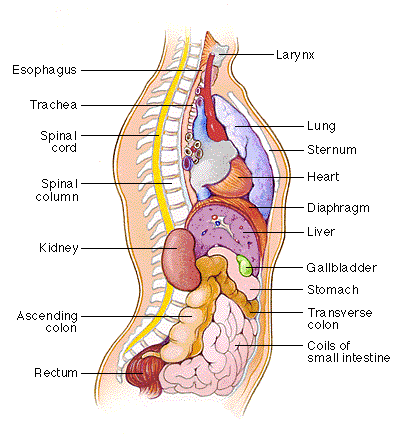
1. 4 Basic organs of the body

It can be tricky to know the inside of your body. Many people don’t know where their thymus, or kidneys or lungs are, or what these organs do.
Heart. Your heart is at the front of your chest on your left hand side. It is between the two lungs. The heart muscles pump blood around your body. You know your heart is working because you can feel your heart beat and you can feel the blood at your pulse.
The heart pumps blood containing oxygen to every part of your body. At the same time, it pumps the blood without oxygen back through the lungs where it picks up new oxygen, This cycle is repeated every time your heart beats, 24 hours a day, everyday.
Lungs. Your lungs are sponge-like organs. Every time you breathe they filter oxygen from the air through tiny vessels into your blood. The blood is then carried to the heart to be pumped round your body. When you breathe out, your lungs also filter carbon dioxide from your body.
Liver. Your liver is an organ below your lungs. It acts like a filter for the blood. Chemicals and impurities are filtered by the liver, including from drugs and medications. The liver does many other essential jobs. For example, it makes and processes many body fats. The liver is the only internal organ that can regrow.
Kidneys. Your kidneys are also filters. Some drugs are filtered more by the kidneys than by the liver. Waste products filtered by the kidneys leave the body as urine.
The kidneys are in your lower back. Any blockage to your kidneys is extremely painful and can cause permanent damage. Although you are born with two kidneys, many people live very well with just one.
Stomach and intestines. Your stomach is where food, drink and oral medications start to be broken down and processed in the body. Nutrients and drugs are absorbed through the stomach and small intestine walls. The small intestines are about five metres long. The large intestines are about 1.5 metres long.
Thymus. The thymus is a small gland high in the chest. This organ is where CD4 cells and other white blood cells develop. CD4 cells are sometimes called T cells (from ‘thymus’). They are part of the cellular immune response. The thymus is very active in children and adolescents, and becomes much less active as you grow older.
Pancreas. Your pancreas is a pistol shaped gland below the liver. It releases digestive enzymes into the small intestine and hormones that control sugar levels in your blood. You can live without a pancreas but you need to take insulin to regulate blood sugar levels and take supplementary digestive enzymes.
Skin. Your skin is the largest organ in the body. The skin makes up 16% of an average body weight. It holds your body together, stops you from drying out and is the main barrier against infection.
Bone. Your bones are a living material. About 10% of bone cells die and are replaced each year. If bone cells are not replaced quickly enough, bones becomes brittle and break more easily. This means that over ten years you have grown and replaced your whole set of bones. A bit like a snake shedding it’s skin.
Bone marrow. Bone marrow is the soft tissue inside bones. Blood cells originally come from bone marrow. Some immune develop in bone marrow – and are called B-cells. Thare are part of the adaptive immune response.
Blood. Blood is the fluid pumped by your heart. It delivers oxygen and nutrients to every part of your body and carries waste products away. Blood contains cells (red cells, white cells, platelets etc) and plasma.
Plasma. The liquid part of blood that contains nutrients, sugars, proteins, minerals, enzymes, and other substances – but with the blood cells taken out.
Lymph. Lymph is a clear fluid that contains white blood cells and antibodies. It is distributed round your body through a series of lymph vessels, nodes, and organs. The lymph system supports the blood in removing waste products from the body.
Although a lot of information about your health and HIV comes from blood tests, less than 2% of the HIV in your body is in your blood. Some researchers think this may be less than 1%. Most of the other 98% is in the lymph system, including the gut.
Lymph nodes. Lymph nodes are the little lumps that sometimes get enlarged in your neck, under your arms, and in the crease between your legs and your body. Most of the CD4 cells in your body rest and reproduce in your lymph nodes.
Further reading and web resources
Many online resources explain basic biology, immunology and other medical terms.
The following sites may be useful on anatomy:
In the US, a 39-year-old man on death row donated his body to science. After he was executed, his body was frozen, cut into one-millimetre-thick slices, and photographed. The data were made available online in 1994 by the US National Library of Medicine.
To view two- and three-dimensional representations of the human body based on these data, visit these sites:
www.nlm.nih.gov/research/visible/visible_human.html
Britannica.com – a range of learning articles on human anatomy, with different levels of complexity (kids, student, scholar).
kids.britannica.com/students/article/human-anatomy/272852
Last updated: 1 January 2023.
